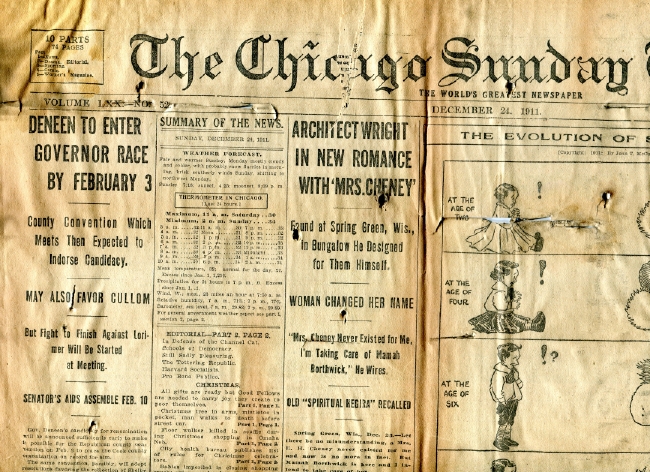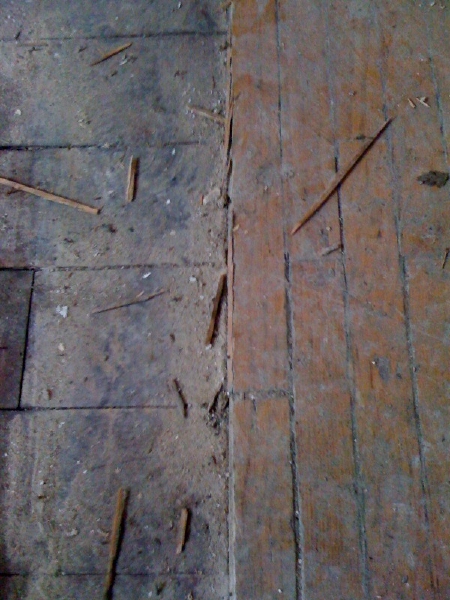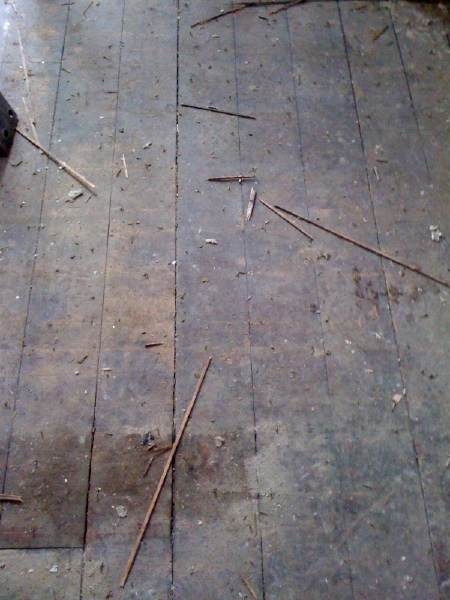Even though we're making a lot of changes to our 1885 Victorian, we do love the old stuff, and are trying to preserve as much as we reasonably can. We're keeping the old windows with their storms, for example -- just
stripping off layers of white paint and making sure the windows function smoothly. We need to take down an interior chimney (that used to run from a boiler that's no longer in use), but we'll be saving as many of the bricks as we can to re-use elsewhere. And so on.
As you may remember, we were very sad when the flooring guy looked at our wood floors and told us
they were too far gone to save. They'd been sanded and refinished so many times that the thin strip oak slats were down to the tongue-and-grooves; it just wasn't feasible to save them. So we sighed, and agreed to put in new wood floors.
But then, while Pam was cutting into the flooring to get temporary furnace access for the
Advanpro Calgary furnace repair contractors we hired, she discovered something wonderful. Underneath the thin strip oak, were layers of newspapers. And underneath the newspaper, there was....[drum roll, please]....another wood floor!
Please note the scandalous article about Frank Lloyd Wright (famous Oak Park resident and architect) on the front page of one of those papers:

The date on the newspapers tells us that the floors were redone in 1911. The first deed to the house was in 1885, but 1895 fire insurance map records at the Historical Society show that the house didn't at that point have its wrap-around front porch. Photos do show the porch by 1901, so it must have been added by Kate Gerts Lundsford, who owned the property from 1885-1909 (she never lived in the house herself).
Given that the house was purchased in 1909 by Willis K. Gore, who bought another matching lot (with a second matching house) at the same time, we think he was likely a developer. He sold our house to Dr. Needham's family in 1909. So our best guess is that Mrs. Needham didn't like the original floors, which were five inch wide pine planks -- she may have thought they looked too rustic and farmhouse-y; thin-strip wood was generally considered more elegant at that time. (And oak is fancier than pine -- less knotty.) Here are the floors side-by-side (or rather, one above the other).

We've finished removing the thin strip oak now, and are left with wide-plank pine with a lot of nails in it. A lot. When cleaned up, it's a medium golden-brown; we're planning to stain it a bit darker, just so all those nail holes aren't quite so dramatically visible. (Like Mrs. Needham, I don't want my house to look
too rustic. :-)

There isn't enough of the pine for the whole house -- at various points, pieces were cut out of the floors for installing appliances and such, and of course, we're adding some new area to the kitchen, my study, etc. The plan is to patch in as needed so as to end up with the first floor entirely original pine, and about half the second floor. The new master suite area will have new floors -- probably walnut, which Pam has managed to find for an impressive $3/sq. ft., stained to a similar shade. Overall, this will likely save us a few thousand dollars, even with the labor costs for pulling out (carefully) all those nails. But far more exciting than the money is knowing that we get to save and re-use these lovely old floors. It's a real thrill.
Huge thanks to the
Oak Park Historical Society for keeping all of these records and helping me make sense of them! I would have had no idea how to read the cryptic fire insurance map, for example. I think it was Frank Lipo who helped me that day -- thanks so much, Frank!






Such a neat discovery! It’s like the opening scene of a marvellous children’s novel in which the children find something magical beneath the floorboards.
You’ve probably already thought of this, but is there any chance that after you lift that old thin strip oak you could put it back down elsewhere the other way up? Although the top surface is sanded away to nothing, maybe there’s some life left in the bottom?
Robert, I don’t think so; they’d just be too thin and too damaged to be much use. Ah well — they’ve done a hundred years of good service!
What a cool surprise! I agree with Nalo. So neat that you discovered this.
You should frame those newspapers and display them somewhere in that room. Tres cool!
That’s the plan! 🙂 In the front hall, I think.
I need to go find someone who does archival framing; they use special glass, I think, to help preserve them. The sheets are pretty fragile; I had to be very careful with the page I scanned in.
Nifty!
Makes me curious: when people talk about wood floors, they usually specifically say “hardwood” floors, but I don’t know whether that’s because hardwoods make better floors than softwoods, or whether it’s just the phrase people use. Wikipedia tells me that some hardwoods are softer than some softwoods, but I think I’ve heard that pine is relatively soft. So does pine make good flooring?
It depends on what you’re looking for in a floor. Pine is certainly relatively soft, as woods go. See the Janka hardness scale: http://tinytimbers.com/janka.htm
But people make floors out of all of these woods, even the Eastern White Pine. It just means that it’ll mark up more, over time — it’ll show the weathering marks from a rocker rocking, or a dog running.
In the end, it’s more of an aesthetic choice than a durability one. Do you prefer a wood that looks pristine as the day it was laid? Or do you like materials that show their age?
We’re thinking of zinc or copper countertops for the kitchen, for example, which would bewilder a lot of folks who like their counters made of granite or something equally impervious. Zinc or copper will instead develop a rich patina over time. I loves it.
What a lucky thing! Those floors will be gorgeous, and they look spookily similar to some of the images of possible floors you posted awhile back. Just lovely.